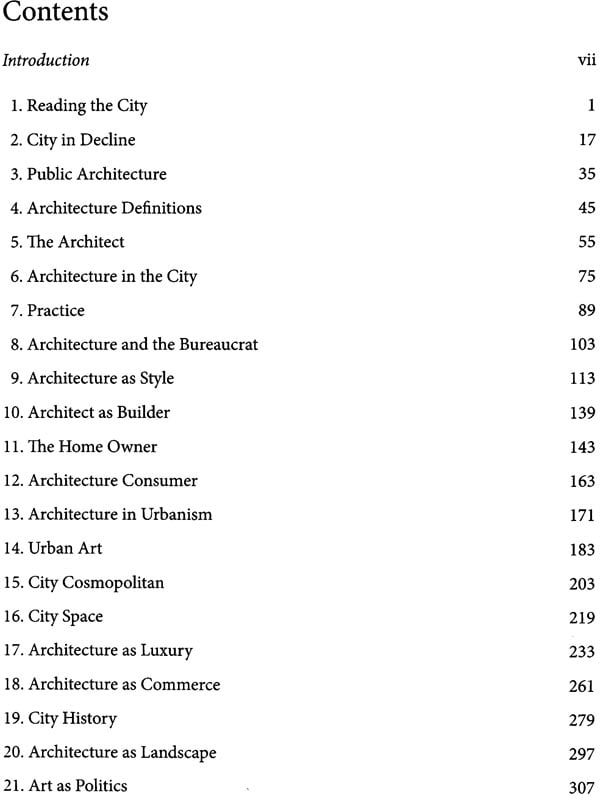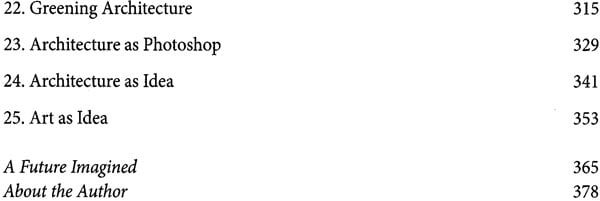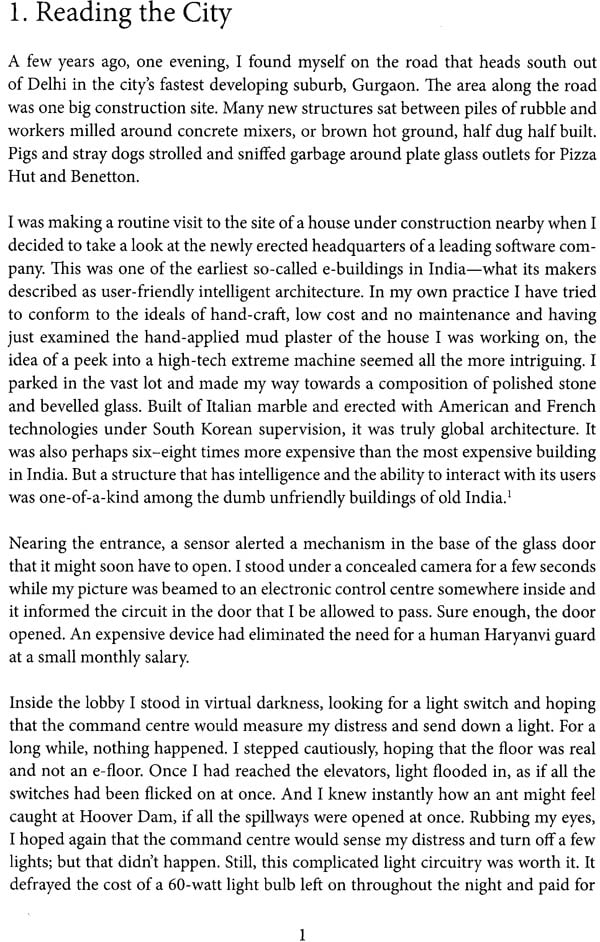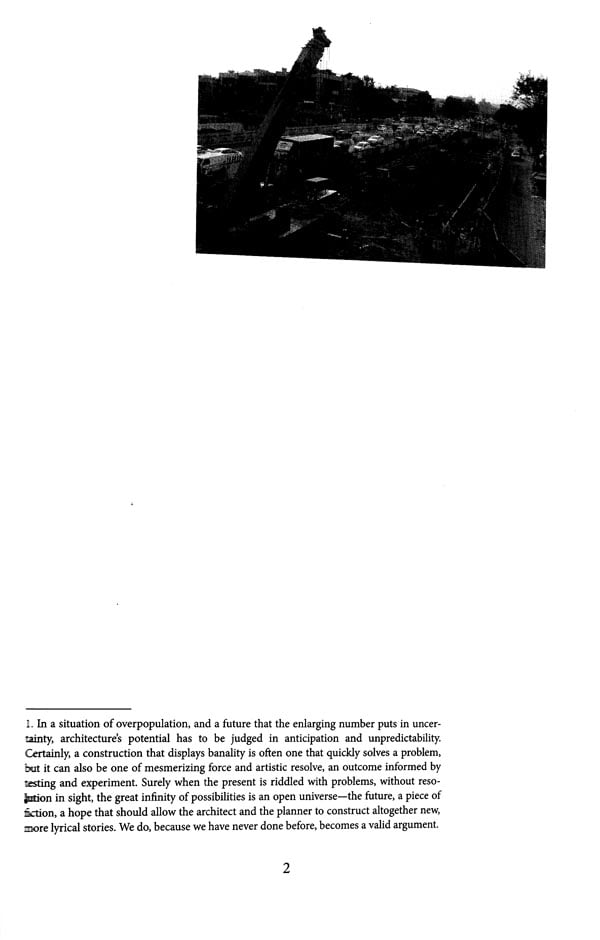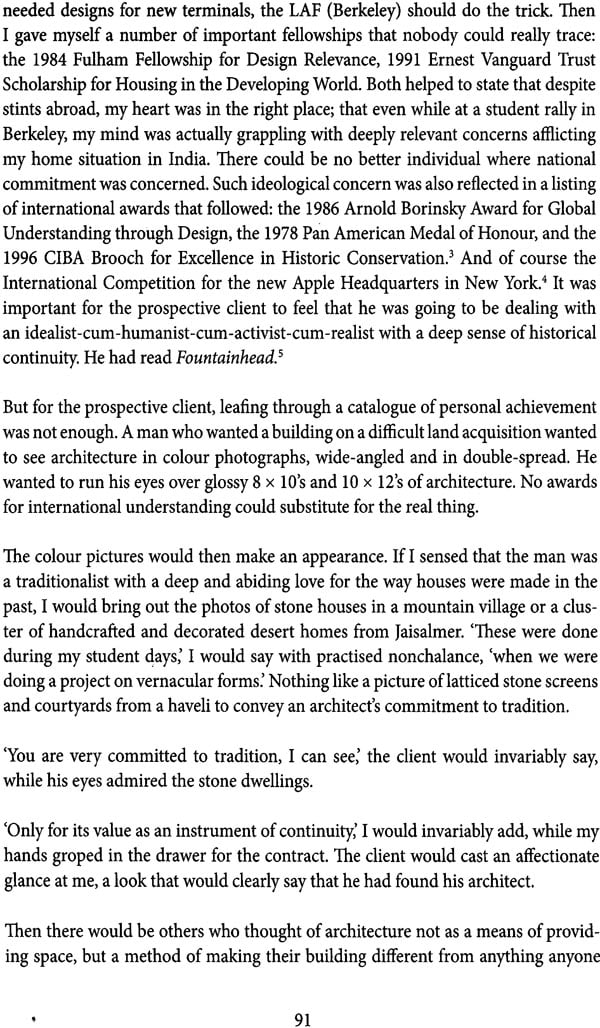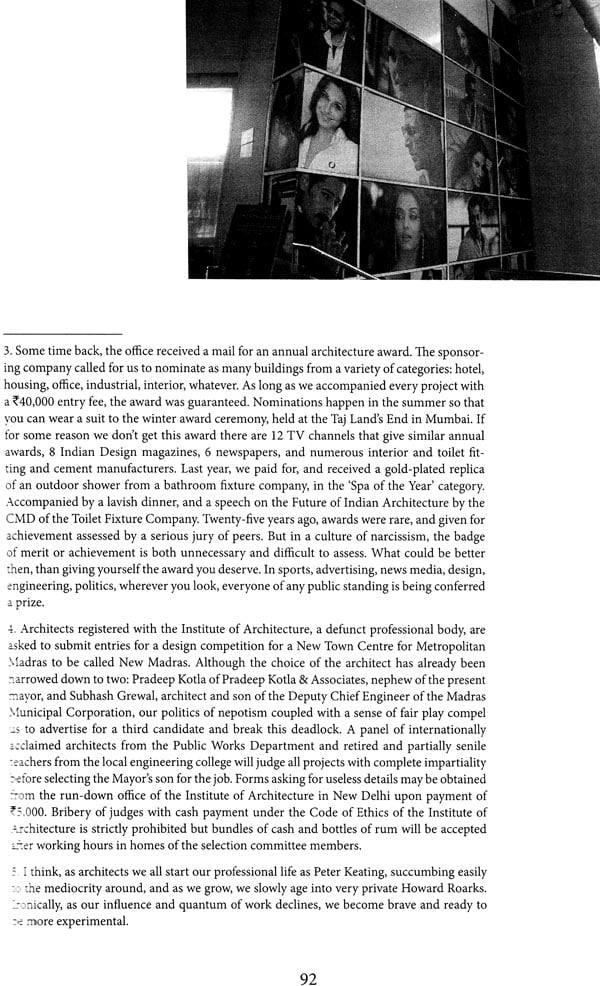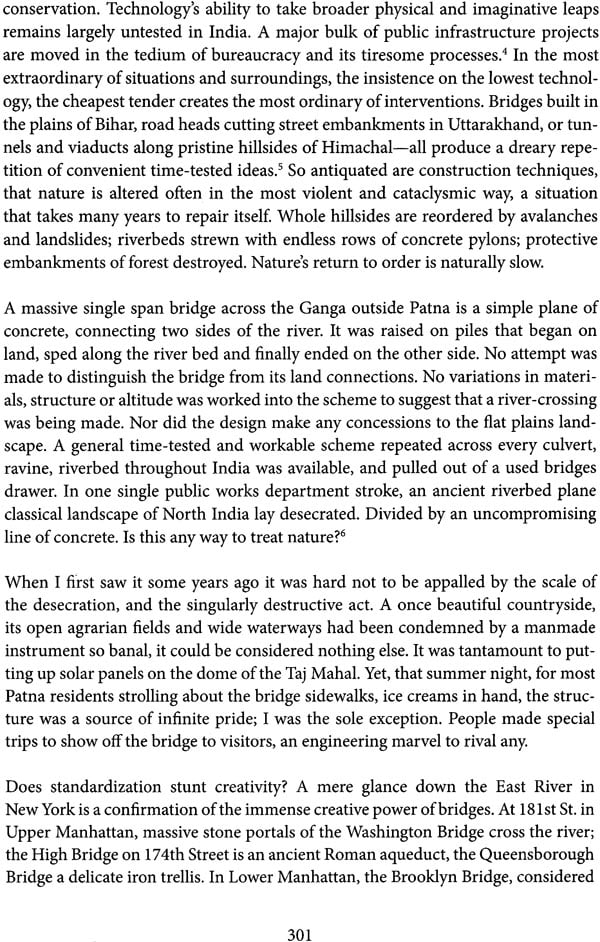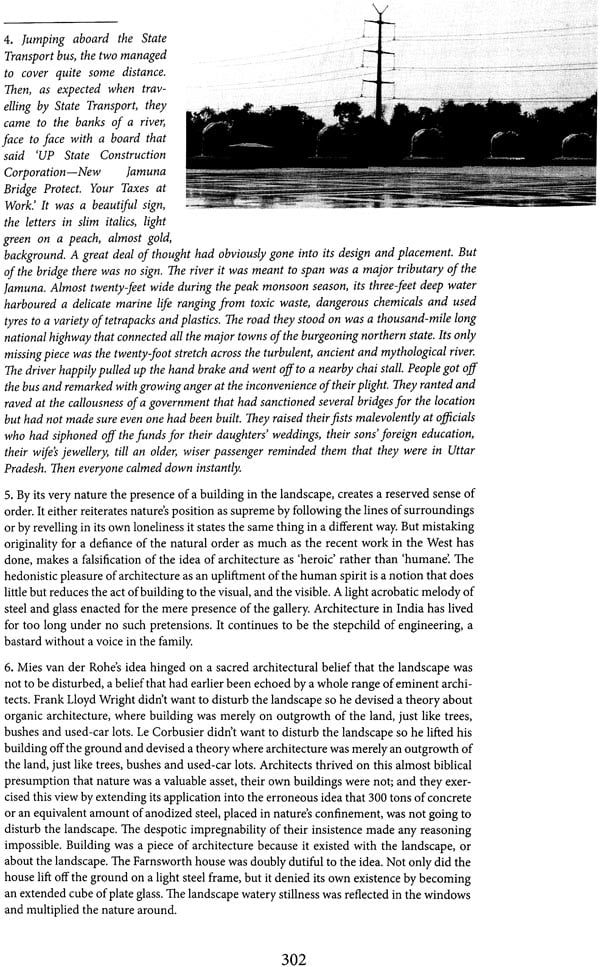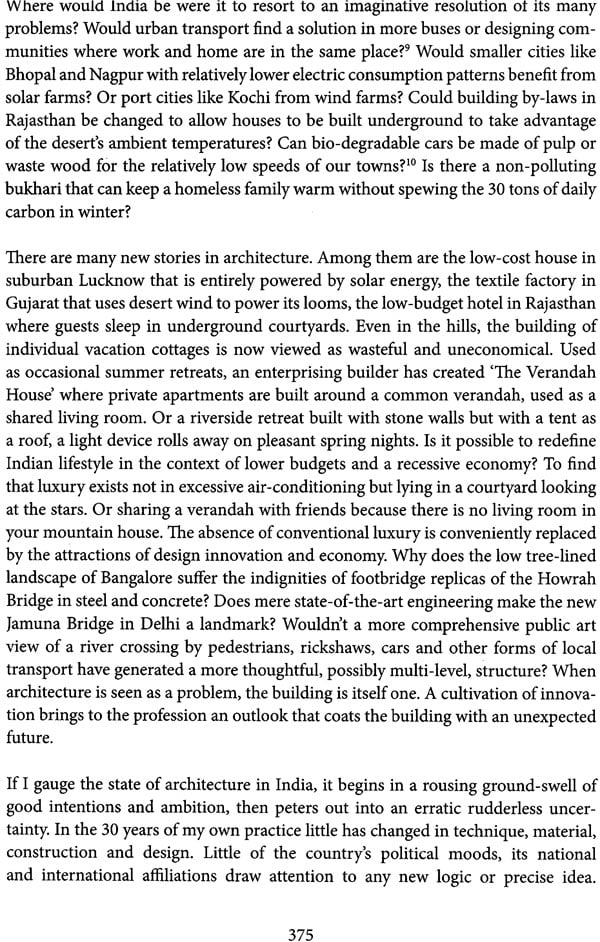
Stories of Storeys: Art, Architecture and the City
Book Specification
| Item Code: | NAQ551 |
| Author: | Gautam Bhatia |
| Publisher: | Sage Publications India Pvt. Ltd. |
| Language: | English |
| Edition: | 2018 |
| ISBN: | 9789353280802 |
| Pages: | 894 (Throughout B/W Illustrations) |
| Cover: | PAPERBACK |
| Other Details | 9.50 X 7.00 inch |
| Weight | 500 gm |
Book Description
The writing consequently has emerged from our continual misrepresentation of design in the city and landscape. The current decade of the 21st century, the period of supposed economic prosperity and growing social respectability, has been unfortunately mismatched by parallel architectural ideas. The Indian city has been painted with a shameful malevolence-with florid and irresponsible brush strokes, creating as a result a sad, opaque and loveless canvas. Glass office complexes, mega malls, imitation apartment towers, Italianate villages or modernist abstractions; the public audience-as unloved and uncaring participants in the work-is left to suffer urban life as an accidental misfit. What happens around, outside the home, in tedious, incomprehensible, dull, chaotic and disjointed assemblies requires infinite patience and tolerance to bear. More and more, the scenery, completely out of control, is getting harder to ignore.
The general levels of despair and squalor in the Indian city are proportionate to those in the profession of architecture. That is but expected in two entities that depend on each other for sustenance. Buildings that fall in the private domain, behind high boundary walls, or in private or institutional complexes make no visible impact on the city. Doubtless, high boundary walls influence the urbanity of places, but buildings that are neither visible nor part of public experience are, to my mind, not architecture. Though these often appear in discussions on design, I look instead at the ordinary, physical, visible and tactile involvement of our urban environment and the way it affects, communicates with, or influences us. The inclusion of buildings, landmarks, landscapes, art, etc., that defines the framework of daily life is the primary subject of the book, physical objects that loom large in daily perspective.
The book attempts to draw on the social life of some of architecture's role players, people whose peculiar demands on design have come to characterize the building environment of our times, this progressive isolation of architecture from the society of common people. Certainly, the rise of new money has given rise to a new scale of construction-public and private-but then do these mega projects spell new ways of living and thinking? Is there indeed a resurgent optimism, a change in the old attitude that India was always a serious problem waiting to be solved? Is there a glimmer of optimism, or is it just a glint in the steel and glass?
I have always felt that a profession that doesn't go by the book deserves a book that doesn't go by the book. My own work, whether building, art or drawing, has never qualified for those wide-angled double-spreads of photographs and plans that make architecture a perfect enticing picture. Most architectural books are a record of the logical sequence of events and ideas that lead to the eventual product of a finely finished and photographed building. For me such a single-minded approach is filled with professional falsehoods that distil architecture into a fine craft of production. More than ever, such a picture in India is elusive, and occurs only in the few short moments between the completion of a building and its occupancy. The real life of Indian architecture is the gut-wrenching reality of space contaminated by too many people with little money and too many ideas of their own-types whose habits and lifestyles don't lend themselves to recording mediums like photography. This then is a book about improbable collisions and unlikely alliances.
Behind the seemingly ordinary life of an architect lie other less professional impulses that give shape to building ideas. Architecture has a social and anthropological aspect that takes it resolutely away from the drawing board and often lands you in the more familiar strata called life itself, life that winds itself around building and gives an altogether different reason for architecture. Unlike medicine or physics, architecture draws its inspirations from ordinary life and returns it with an equivalent maladjustment, an offering of one man's play with its day-to-day conditions. To practice architecture then as a profession, or as a dead beat logic of material assembled according to aesthetic formulae, is a form of suicide. Such practice merely keeps the professional feeling professional. In India the making of building is an agonizing medley that simply cannot be justified by theory.
The book is then an excavation, a digging up of the dirt that evokes unrelated states, the social, literate, personal, petty, lurid and other conditions of architectural undress that liberate ideas on building. I practice as an Indian living in a city, confounded by family, neighborhood, urban blight and affluence, scarred by daily assumptions and visual encounters, and forced into methods not of my choice or making. I am surrounded by a cast of characters who make and unmake my architecture everyday; they are not just builders and masons, but others hiding behind the bush. The bureaucrat, the beggar, the MP, the shopkeeper, whoever they are, their pervasive influence on my daily life and work is also condensed in the book as the virulent strain behind the architecture, the muddled and diseased voices that dam our and contaminate daily life. The book is not a distillation into the sterile preserve of design, but a further confounding; much like the Indian city and its architecture, a piece of visual and literary noise, a personal harangue of all the forces of delirium that go into the making of buildings in India. It is less a social history of architecture, than a social history of one architect, and his contentious reading of the profession, indeed his unsavory maladjustment with the city, its art and buildings. The real value of the exercise lies in the deviant side tracks, the insignificant battles that erupt in the unformed stages of construction corrupting the mind and leading to often imaginary ventures. To me the value of architecture is what I have instinctively derived from that deviation. Prejudiced, dull, trivial, devious, despairing, crass, deceitful, blunt, arrogant, malicious, downright stupid, could describe life in India. I hope they also describe the book.
In recent times the most prolific adventures into architecture at a monumental scale have only been undertaken by two agents: private business and the state. In making an assessment of their endeavors, I have chosen to apprise architecture through five major scales of projects, each a type that expectedly signals a new direction in design, construction, lifestyle, technology and social attitude. At the scale of a city, a comparative measure between the private ideal and the public perception makes Lavas an in Pane and Nay Raipur, the new capital of Chhattisgarh as two distinct symbolic references to the new city. Six decades after Chandigarh, do any of these and other new towns reflect anything of the idealism say, of Nehru's time? Do these places consider the resurgent changes in India-the social upheavals, the burst of new money, the hopes of urbanization, the rise of consumerism, the serious divide between the rich and poor-and anything of the cultural clashes that today mark the Indian city?
The search for a big institutional building led me to the new Infosys campus in Mysore. Developed over several years and incorporating the work of a number of private architects, Infosys has become synonymous with an international pedigree in design, quality and execution of work related to the computer technology industry. A comparison with the Indian Institute of Management campus in Ahmadabad seemed natural, given the two were built in recognition of an emerging professional
Book's Contents and Sample Pages
